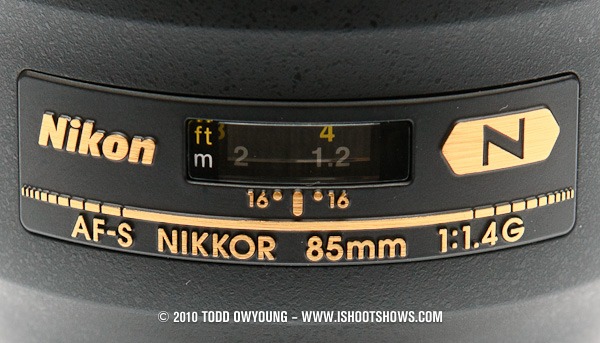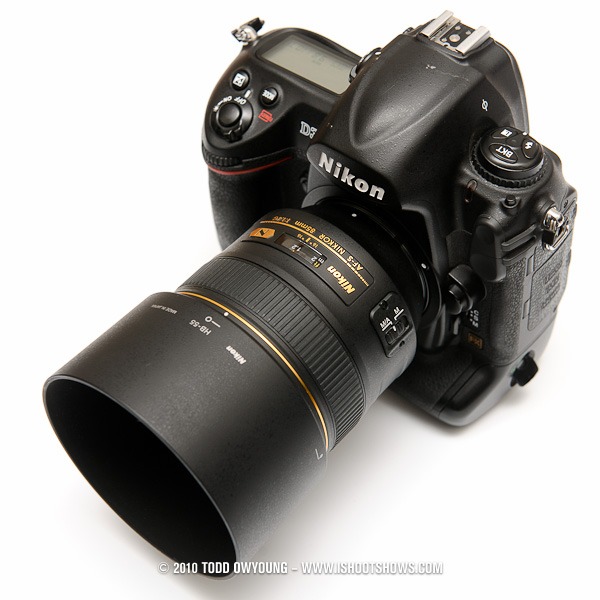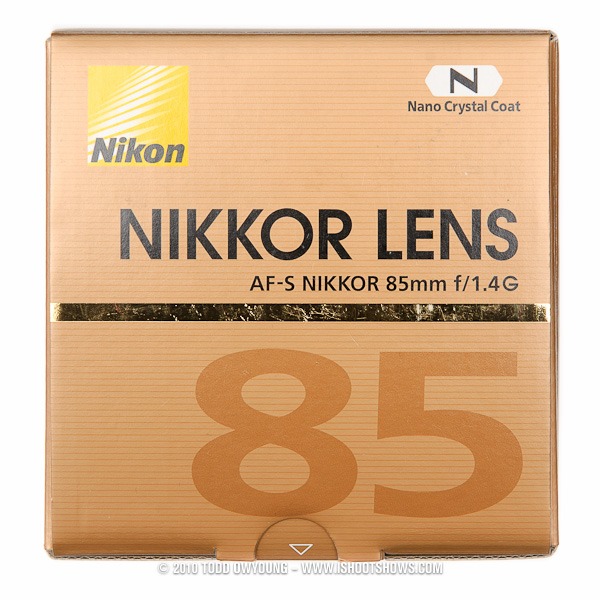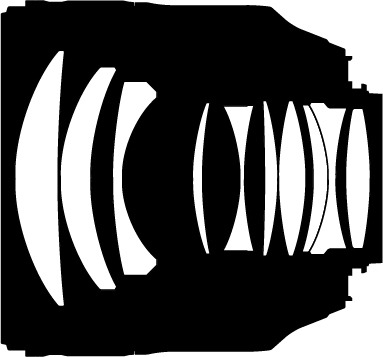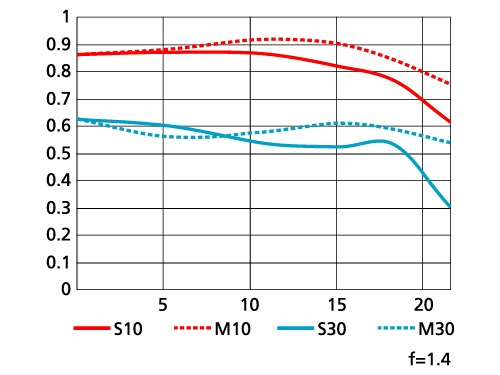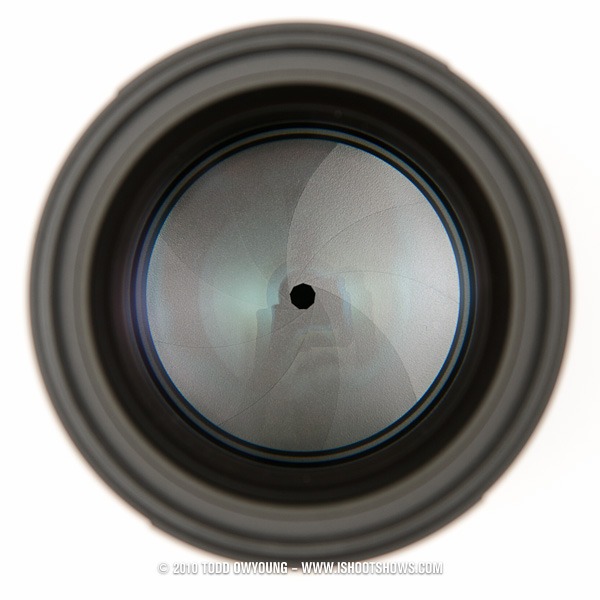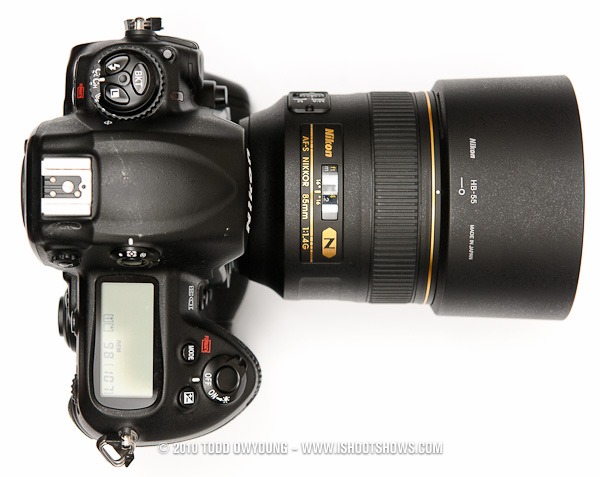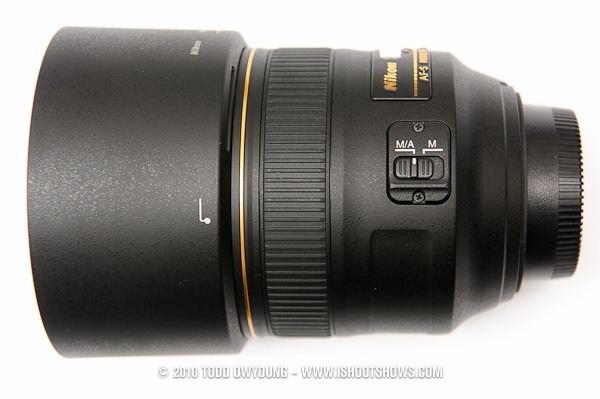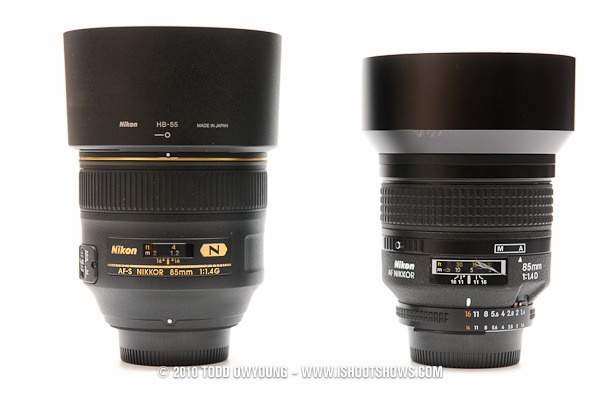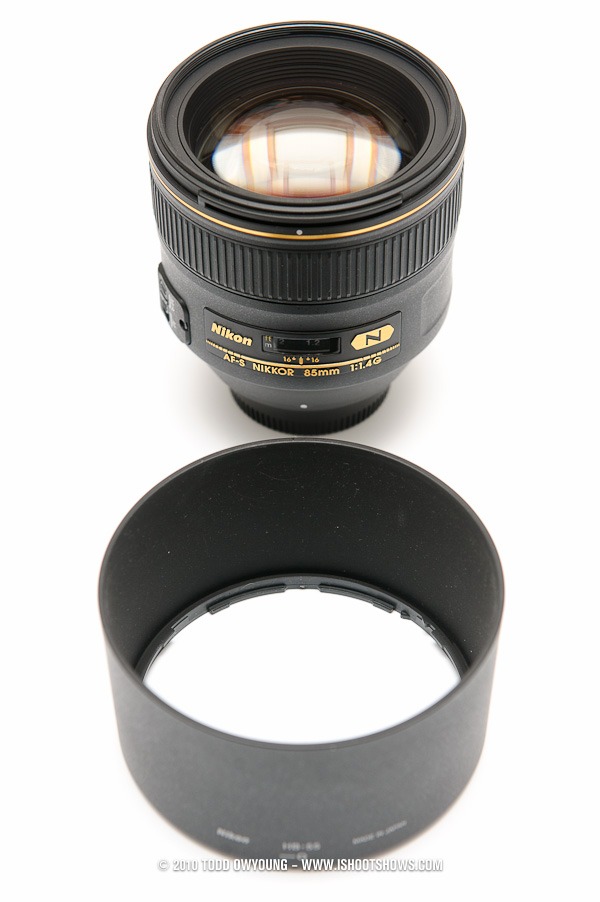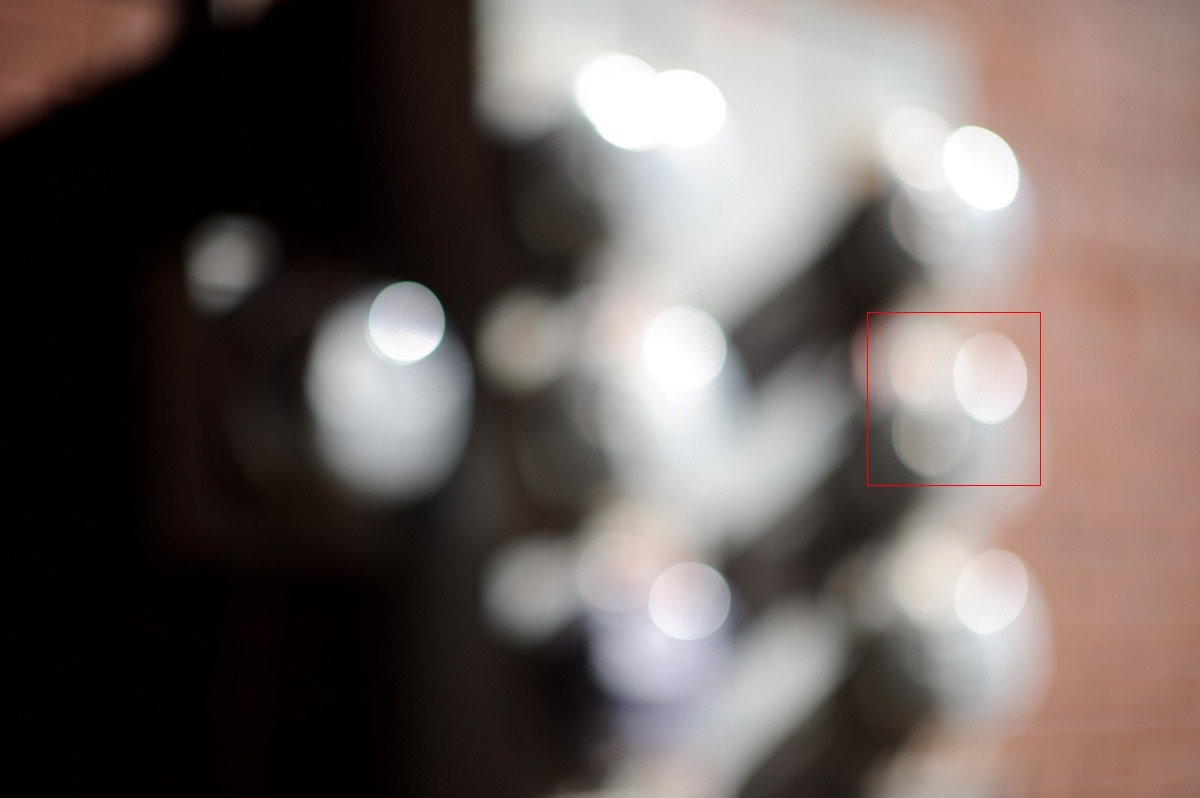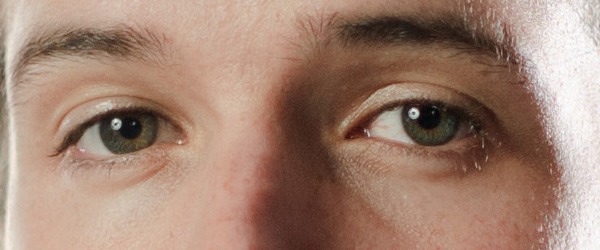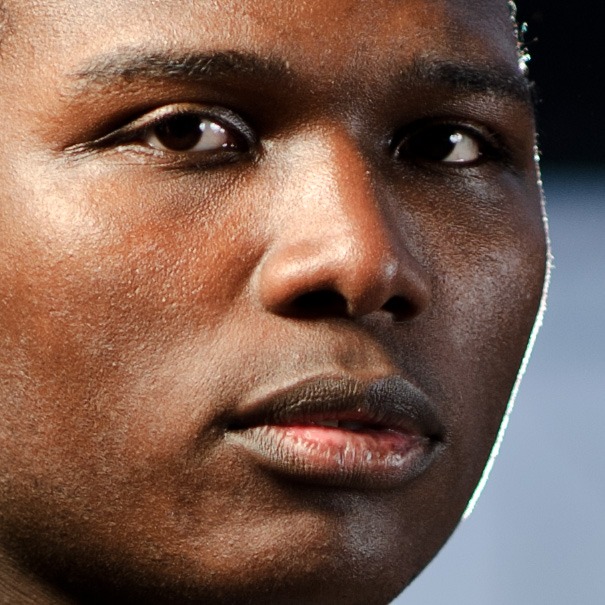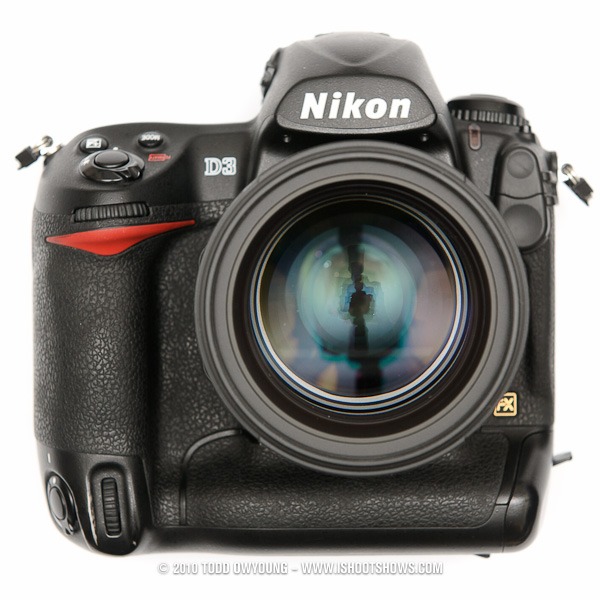The classic 85mm f/1.4 – a long-admired and respected lens in any mount, and especially renowned as the Nikon AF-D, introduced in 1995. As part of their recent push to update all their fast primes – and introduce a few new ones – Nikon's new 85mm f/1.4G AF-S with Nano Crystal Coating represents a fully modern lens that improves on its predecessor with seemingly none of its weaknesses.
Here is my detailed review of the Nikon 85mm f/1.4G AF-S, a much-anticipated 2010 update to the old AF-D model.
Support These Reviews
The Nikon 85mm f/1.4G AF-S tested in this review was provided by B&H, where I personally buy all my camera gear. If you find this review helpful, please consider buying your next photo gear purchase from B&H, Amazon.com, or any of my other my affiliate links.
To learn how you can help support www.ishootshows.com, visit the page Buy Yourself Something Nice. Now with that out of the way, let's get to the review.
Lens Specifications
|
Focal length
|
85mm
|
|---|---|
|
Maximum aperture
|
f/1.4
|
|
Minimum aperture
|
f/16
|
|
Lens construction
|
10 elements in 9 groups (with Nano Crystal Coat)
|
|
Angle of view
|
28°30’ (18°50’ with Nikon DX format)
|
|
Minimum focus distance
|
0.85 m/2.79 ft.
|
|
Maximum reproduction ratio
|
0.12x
|
|
No. of diaphragm blades
|
9 (rounded)
|
|
Filter-attachment size
|
77mm
|
|
Diameter x length
(extension from lens mount) |
Approximately 86.5 x 84 mm/3.4 x 3.3 in.
|
|
Weight
|
Approximately 595 g/21.0 oz.
|
|
Supplied accessories
|
77mm Snap-on Front Lens Cap LC-77, Rear Lens Cap LF-1, Bayonet Hood HB-55, Flexible Lens Pouch CL-1118
|
Optical Design
MTF Chart
Looking at the MTF chart supplied by Nikon, we can see that the new 85mm has remarkably even performance even at f/1.4, with both contrast and sharpness almost level to all but the extremes of the frame. In contrast to the old AF-D model, this is a subtle but welcome improvement.
What's In The Box
The new 85mm comes with all the standard goodies – a soft lens pouch, lens hood, and all the associated literature you'd expect.
The lens pouch is tall enough that you can store the lens standing up with the hood attached.
Key Features
As per Nikon's own product page for the Nikon 85mm f/1.4G AF-S:
- Fast 85mm lens with a maximum aperture of f/1.4
- Newly developed optical system realizes high picture quality and high performance
- Nano Crystal Coat virtually eliminates internal lens element reflections to effectively reduce ghost and flare
- Refined MF driving mechanism reduces focus time lag and improves operational ease in M/A mode
- With the internal focusing (IF) system, the lens barrel length does not change during focusing
Fast f/1.4 Aperture
Needless to say, the fast f/1.4 aperture of the 85mm one of the prime features. This aperture is a full two-stops faster than your average f/2.8 zoom. But aside from raw speed, this large aperture also translates into the ability to render a more shallow depth of field.
In addition, there are performance benefits from this large aperture. Not only is the 85mm f/1.4 designed to be used at wide aperture, you also get the benefit of improved image quality (sharpness, contrast, etc) when you do stop down to where those “slow” zooms are just starting.
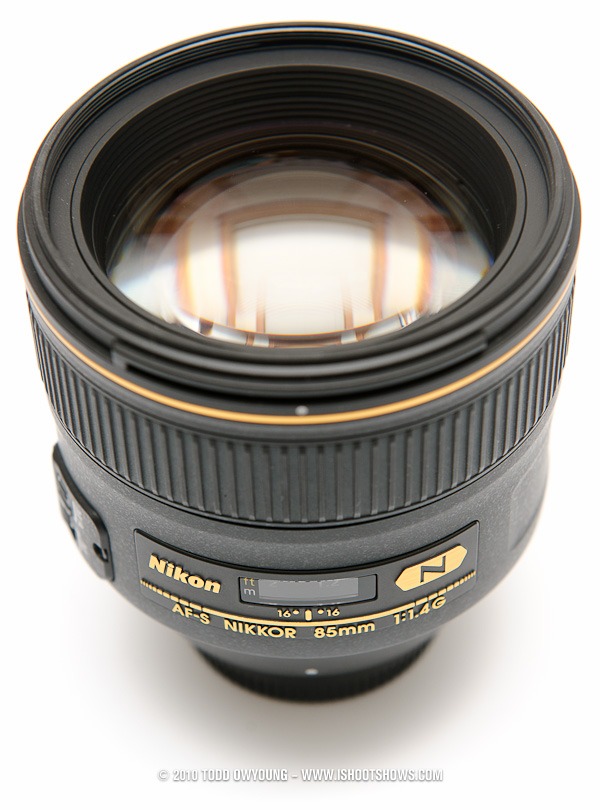
AF-S – An Upgrade Years In The Making
As you may know, Nikon has been slowly updating their stable of fast prime lenses. Previously, Nikon users have relied on older models like the Nikon 85mm f/1.4 AF-D and Nikon 50mm f/1.4 AF-D, both of which are driven by the older system of an AF motor built into the camera body. This wouldn't be an issue, except that Nikon has recently created a schism in their lineup, reserving this in-body motor for more expensive DSLRs and leaving many users without an option for fast, AF prime lenses.
With the AF-S updates to the 85mm f/1.4 and all of Nikon's other new primes, the AF motor is built into the lens, so they are usable on any current Nikon DSLR.
Nano Coating
I've said it before and I'll say it again. I love Nikon’s Nano Crystal Coating. It's like bacon – it just makes everything better. Nikon's new proprietary coating may just be marketing hype, but I have to say it's working, because every lens that's been spanked with Nano has delivered beautiful color and contrast, even in tough lighting situations.
On paper, Nano coating is a multi-coating that reduces ghosting and flare. But together with the new optical designs Nikon has been rolling out, this new generation of lenses just has a fantastic quality that I love. Beautiful, natural contrast that's more like looking at reality than an image.
Design & Usability
Ergonomics & Design
Overall, the new 85mm f/1.4 is a great lens to use. In fact, I dare say that it's a perfect size to handle with either a camera like the Nikon D700 or a full-sized camera like the Nikon D3s.
The prime features a relatively square shape – it actually feels like you're holding a softball – and balances extremely well with just about any camera you can throw at it.
Controls & Switches
As a prime lens, there's obviously no zoom ring on this lens – just a single knurled ring for manual focus. In my opinion, the manual focus experience with this lens is as good as I've had with an AF lens. The focus ring is smooth and quite well damped without any slop. The MF ring definitely feels nicer than on the old AF-D lens I own.
The switches on the side of the 85mm f/1.4 are the standard M/A -M switch to toggle between Autofocus with Manual override or Manual focus-only.
Size Comparison: AF-S vs AF-D
The two 85mm f/1.4 lenses are relatively similar in size, though the new AF-S model is fatter and bulkier, especially when you factor in the included lens hood.
Lens Hood
The lens hood for the new 85mm features a friction lock, so it just twists on and snaps into place. This isn't as convenient if you need to unlock and reattach the hood often, but if you're the kind of shooter who keeps the hood in the active position all the time (like me), this setup is perfect.
Build Quality
The build quality of the new 85mm is great. It's a solid, fat lens with internal focusing and a pretty dense feeling overall. And for the price, it better be.
Performance – AF Speed & Precision
In use, I found the new 85mm very close in terms of the speed of AF acquisition next to the old AF-D model. Where the new lens pulls ahead is in the precision of that AF lock and performance in low light, where I found the new AF-S lens performing with a confidence lacking in the AF-D design.
The one criticism of the AF performance of this lens that very dim, low contrast light is not a strong point.
In terms of operation, the new AF-S lens focuses whisper-quiet compared to the clicks and whirrs of the older, screw-driven lens.
Overall, the AF speed is good, though it's not as fast as AF acquisition with zooms like the Nikon 24-70mm f/2.8 or the new 70-200mm f/2.8 VR II. That said, I had no issues using it for the demanding task of concert photography, which I think is a pretty big test under adverse conditions. The 85mm even kept up with singer Janelle Monáe, pictured below, who is a firecracker on stage.
Performance – Color & Contrast
One of complaints about the old AF-D lens was that like Nikon's other fast AF-D primes, the color and contrast rendering had an airy, less snappy look than more recently introduced lenses.
I am very pleased to say that the new AF-S version of the 85mm f/1.4 offers a character that is more in line with lenses like the Nikon 24-70mm f/2.8 and new 70-200mm f/2.8 VR II. The new 85mm is noticeably more contrasty wide open up to about f/4, at which point images from the two lenses feature almost identical contrast.
One interesting point on the color of the lens is that, compared to the old AF-D lens, the new AF-S lens features a visibly warmer tint under identical shooting conditions and WB settings. The difference isn't huge, but it's worth noting in the below comparison samples.
Performance – Defocusing Quality
Aside from the pure speed of a fast aperture, one of the reasons many people looked to the old 85mm AF-D lens was very shallow depth of field it could render. The new AF-S incarnation, with nearly identical specifications, carries on this tradition for all the bokeh fanatics, but with some subtle changes.
In my shooting with the new 85mm, I found that this lens offers a beautiful rendition of out of focus elements in degree of smoothness that the old AF-D lens never produced. Even when stopped down, the lens offers a very smooth character with defocused elements. And naturally, these defocused elements keep a circular character thanks to the nine rounded diaphragm blades, just like the AF-D model.
Bokeh – AF-S vs AF-D
For all you bokeh-heads, here are my comparison samples comparing the two lenses and their performance with regard to rendering defocused elements.
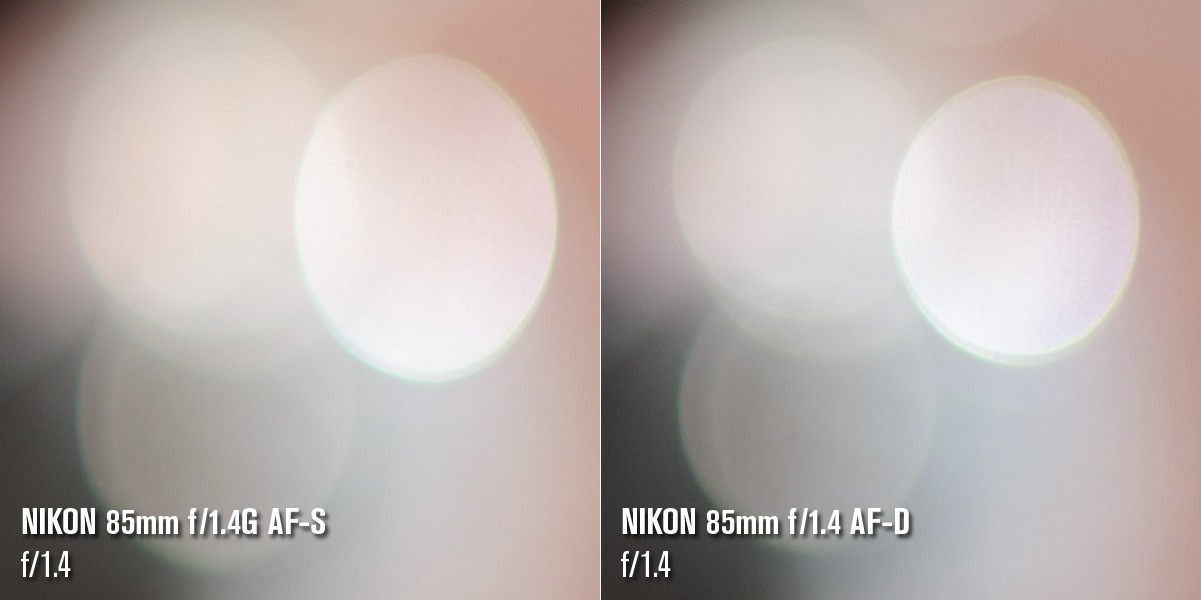
Aperture Test – f/1.4 though f/4
The below test scene is of a bush in full sunlight, which creates plenty of highlights to throw at the 85mm primes. Here, the lenses are both focused at 1.2-meters, while the bush was approximately 3.5-meters away.
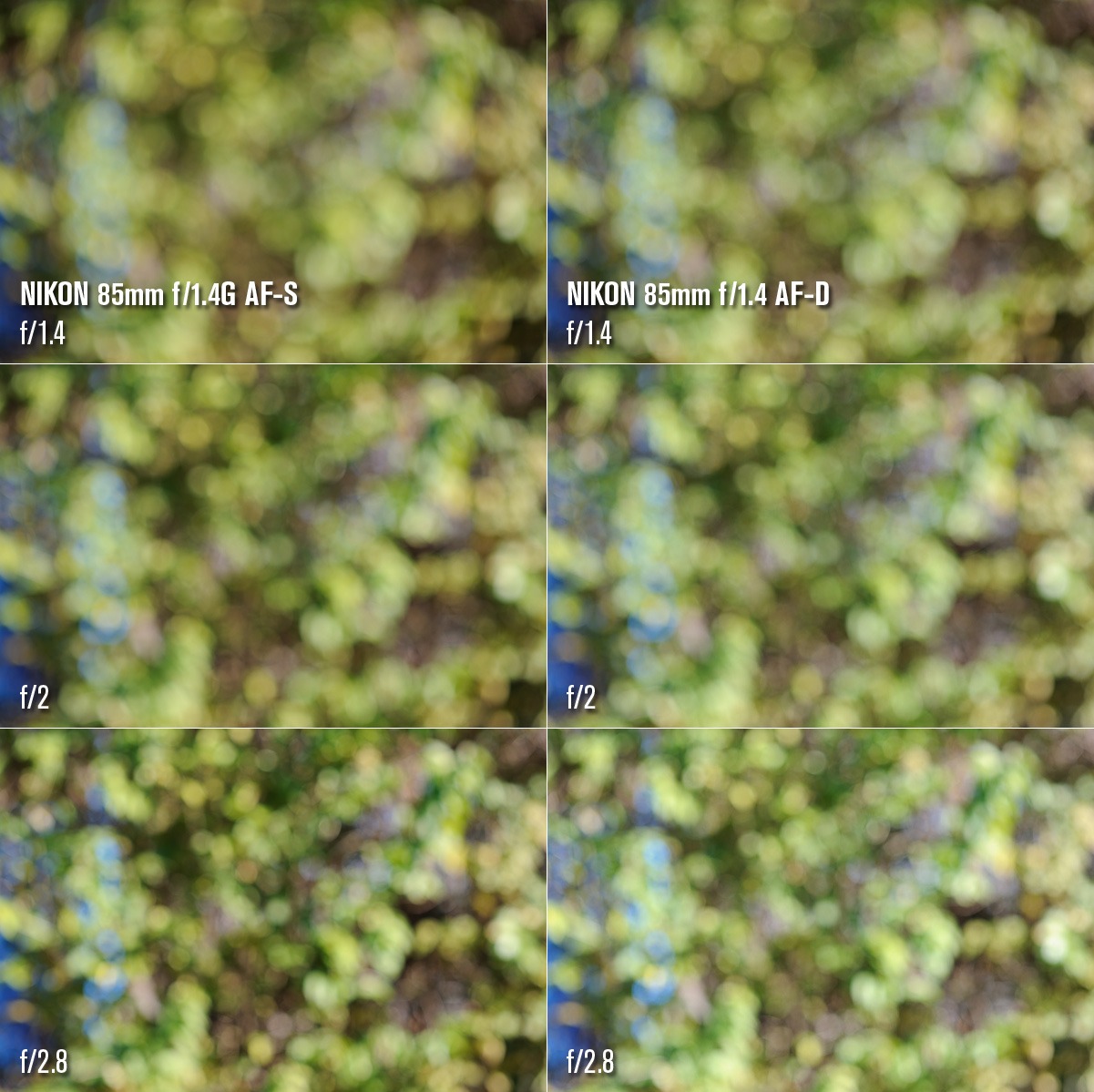
Complex Scene Test
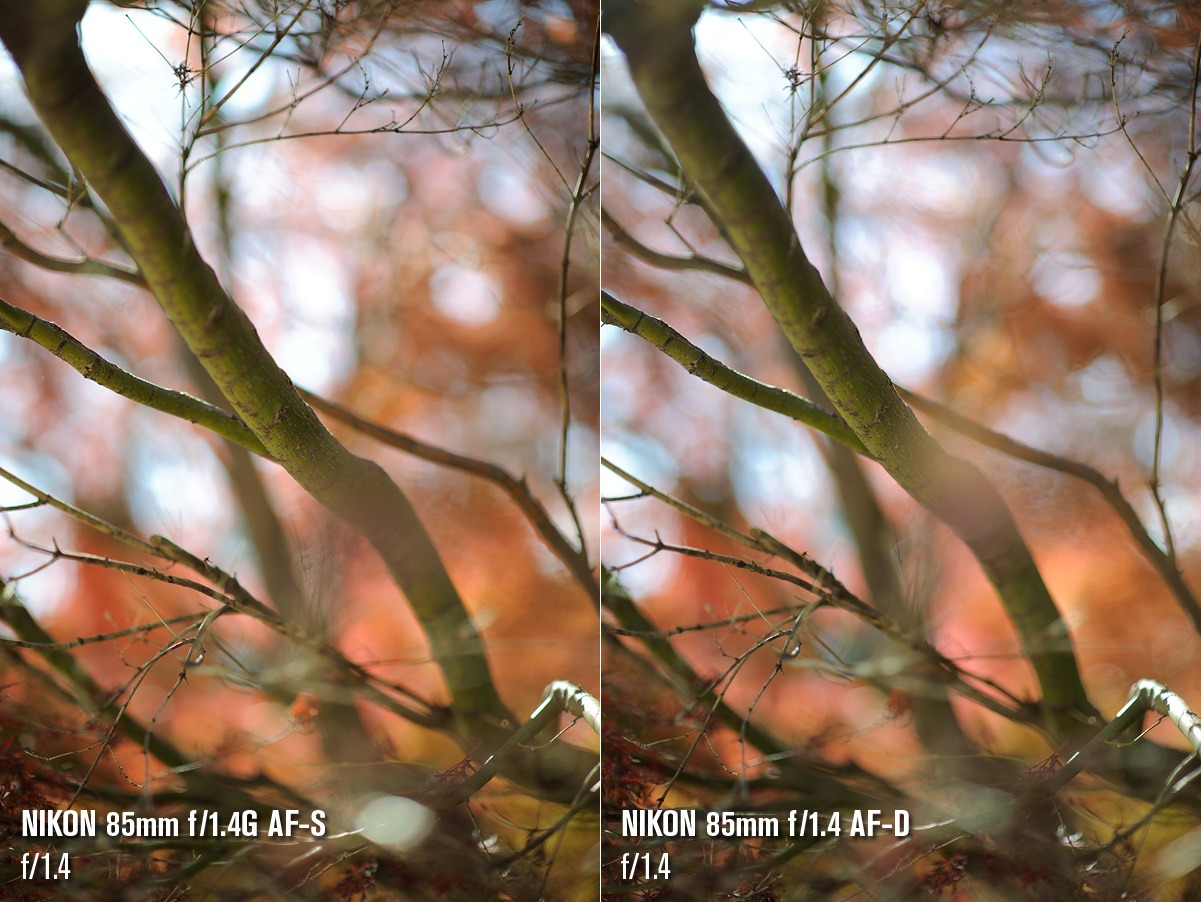
Overall Bokeh Analysis
Overall, I found that new 85mm f/1.4 AF-S offers a smoother and more personally pleasing rendition than the older AF-D model. The differences are slight, but the new lens offers smoother blending and less edge harshness of defocused highlights than its predecessor.
In all frankness, I was never sold on AF-D as legendary in regard to its ability to render a smooth scene. I think that the AF-D's “creamy” character was largely an urban myth was perpetuated by users who confused genuinely smooth character with shallow depth of field.
Ironically, I do think that the new AF-S version of the lens starts to live up to the renown of the AF-D design in a way that older lens never did. For anyone interested in the smoothest character in the 85mm focal length, I think you've found your new lens.
For photographers interested in more bite to their images, the old AF-D lens is a better choice, as it renders defocused with more visual interest. Fans of this style of rendering might find the new AF-S a little too bland, by comparison – and to each their own.
Performance – Purple Fringing
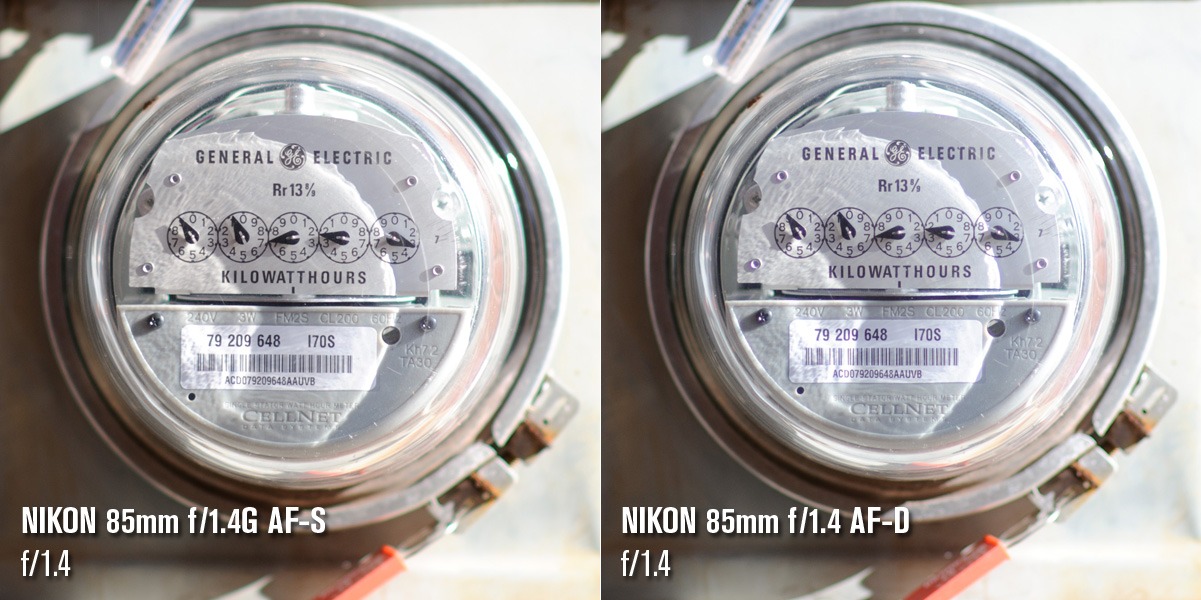
For any user of the old AF-D version of the 85mm, purple fringing and chromatic aberrations at wide aperture are a perpetual issue in areas of high contrast and specular highlights.
As expected, the new AF-Slens performs much better at f/1.4 – exceptionally so, in fact. In all but the most extreme circumstances, I found that purple fringing with the new 85mm is essentially absent, even wide open.
Even in the scaled version of the above sample, you can see that the new AF-S model controls this fringing much better than the old AF-D lens.
Again, you can also see the difference in the color rendition between the two lenses quite clearly as well, even with the same WB settings and shooting conditions.
Image Performance – Sharpness
I will get straight to the point on this issue: the new Nikon 85mm f/1.4G AF-S is crazy sharp. Even wide open at f/1.4, if you nail the focus, this lens delivers. While there are many primes that are usable wide open, there are few that I've used that are as good as this lens is at maximum aperture.
Closed down a stop, and this 85mm delivers performance that leaves me wanting nothing in terms of sharpness. But talk is cheap, so here are some samples – full-frame first, then the 100% crop for all you perverted types.
Full Frame:
100% Crop:
- Camera: Nikon D3
- Lens: Nikon 85mm f/1.4G AF-S
- Aperture: f/1.8
- Shutter speed: 1/200
- ISO: 200
Full Frame:
100% Crop:
- Camera: Nikon D3
- Lens: Nikon 85mm f/1.4G AF-S
- Aperture: f/2
- Shutter speed: 1/80
- ISO: 200
Both of these samples were converted from RAW in Adobe Lightroom 3 with the default sharpening settings. With customized sharpening, we'd be seeing even more detail here. Also, one thing to note about the second crop is is that it's from the outer edge of the frame at f/2.
To be honest, I feel a little silly even posting these crops, because this lens is so good that image quality is a complete non-issue. To make up for this foolishness, here are plenty of samples shot with new 85mm.
Samples – Wedding Photography
The new AF-S 85mm is one of those lenses that can take just about any kind of background you throw at it and spit out gorgeous blur.
In this sense, a fast telephoto like the 85mm is a great equalizer – nasty backgrounds and pretty backgrounds alike are ground up into a feathery mush with ease. Needless to say, it's a great lens for wedding photography.
With constantly changing shooting conditions and a myriad of backdrops throughout a day, the speed and beautiful depth of field of the 85mm f/1.4 at wide apertures makes it a joy to shoot with.
I loved shooting the 85mm at f/2 to wide open at a recent wedding shoot – here are some samples.
Samples – Portraits
Personally, I prefer a slightly longer lens for individual portraits, but even so, I found the 85mm a simply beautiful lens for portraiture on the full-frame Nikon D3. The extra reach of the 85mm, coupled with the wide aperture, is just enough over the Nikon 24-70mm f/2.8 to create beautiful separation between a subject and background.
On a cropped sensor like the Nikon D300s, D7000, or similar camera, I think that the new 85mm would be an ideal portrait lens, giving a field of view similar to the classic 135mm portrait range on full-frame.
Samples – Low Light Action Portraiture
(AKA Live Music Photography)
As you may know, I am a music photographer. I shoot everything from small clubs to arenas, and everything in between, so the flexibility of a fast prime is something that is a huge boon when I face less than ideal light.
The Nikon 85mm f/1.4 is one of those lenses that can take a dismally dark concert treatment and make it look better than you ever thought possible.
As a concert photographer, I shoot in all kinds of unpredictable lighting, even at larger clubs. While the new 85mm isn't a lens you'll need photographing the biggest arena tours, I was thankful to be carrying it for countless gigs I covered on assignment while I had it on loan.
Give me f/1.4 and a Nikon D3 and I will it rain. Or if not rain, at least shoot in the dark.
Summary
Overall, what gets me excited about this lens isn't so much the fantastic performance, but the signal of commitment by Nikon to put out great glass for professionals and dentists. Nikon has taken an outdated lens and given it a fully modern treatment – comparing the AF-D and AF-S lenses side-by-side, it felt like a make over episode of Oprah.
The Nikon 85mm f/1.4 is a lens people have traditionally bought for portraiture, thanks to the combination of telephoto compression, reach, and the wide maximum aperture to create subject isolation and beautifully blurred backgrounds. This new AF-S model not only delivers, but surpasses its predecessor in just about every way, including price.
Even as an owner of the AF-D 85mm f/1.4, I have to admit that the new AF-S lens is very tempting. While individually the improved performance in wide-open sharpness, improved contrast, tight control of purple fringing, smoother bokeh, quiet AF operation, et al are not game-changing in themselves, collectively, they are enough to make one want to throw the AF-D lens in the trash and break open the piggy bank.
If you're still reading this and don't want to buy this lens immediately, I'm really not sure what more I can tell you. The new Nikon 85mm f/1.4G AF-S is a lens that's filled with awesome, wrapped in amazing, and sprinkled with whoop ass for good measure.

Where To Buy
The Nikon 85mm f/1.4G AF-S tested in this review was provided by B&H in NYC. If this review and other content on www.ishootshows.com was helpful to you, please consider supporting this site and purchasing your photo equipment any of the links in this review, my support page, or elsewhere on my site.
- Nikon 85mm f/1.4G AF-S
If you do buy through B&H or any of my affiliate links, drop me a line! I’d love to hear about what you picked up. B&H is where I personally buy the vast majority of my gear, and I’m looking forward to bringing you more reviews thanks to their equipment loans.
Questions? Comments?
Do you have questions about the new Nikon 85mm f/1.4G AF-S? Let me know.
If you have this new prime, what do you think of it? Chime in and have your say!

